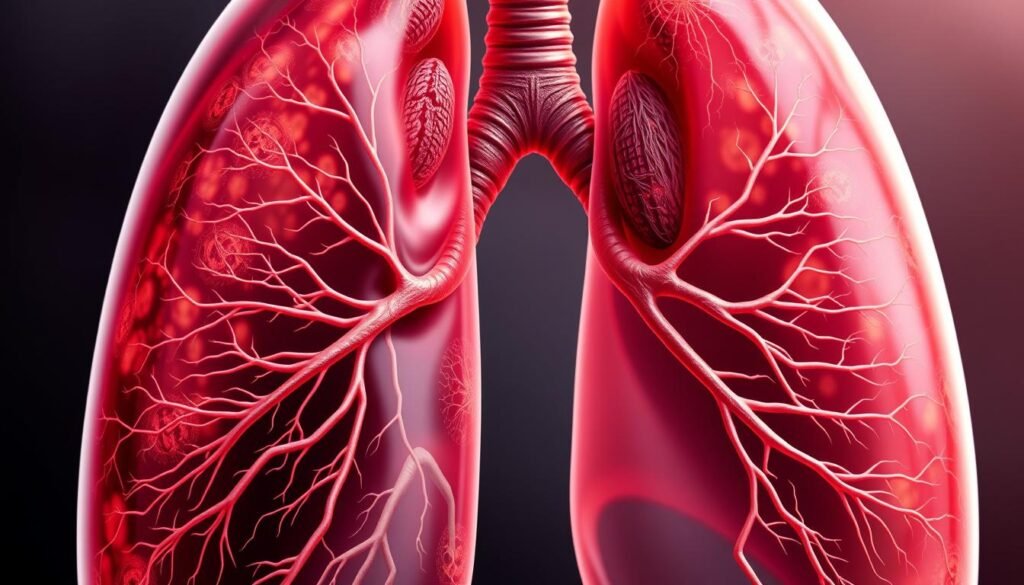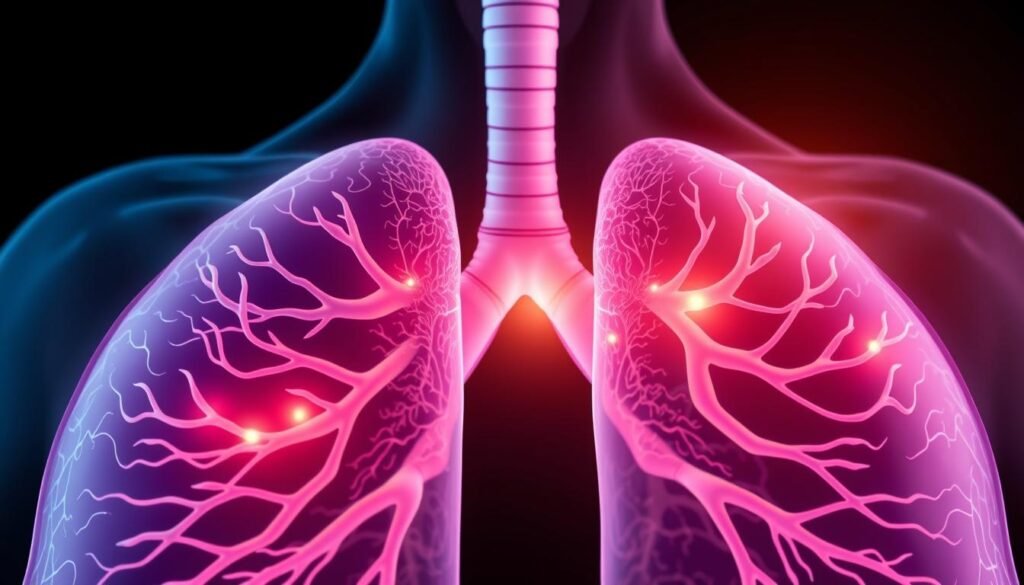Asthma: Understanding Lung Health, Symptoms, Causes, and Treatment
asthma airway lung asthma is a chronic asthma symptom trigger lung disease
Asthma is a long-term lung disease that affects the airways. These are the tubes that carry air in and out of the lungs. It causes inflammation and narrowing of the airways, leading to symptoms like wheezing, coughing, and shortness of breath.
People with asthma have airways that are too sensitive. They react to certain triggers, causing the airways to tighten and swell. This makes it hard for air to move in and out of the lungs, leading to asthma symptoms.
Asthma affects millions of Americans of all ages. It’s important to understand how asthma works, what triggers it, and how to manage it. This helps people with asthma control their breathing better and improve their life quality.
Key Takeaways
- Asthma is a chronic lung disease that affects the airways and makes breathing difficult.
- Asthma is characterized by inflammation, narrowing, and excess mucus production in the airways.
- Asthma symptoms can range from mild to severe and include wheezing, coughing, chest tightness, and shortness of breath.
- Asthma is a complex condition with various triggers and causes, requiring individualized management strategies.
- Understanding the basics of asthma is crucial for individuals to effectively manage their respiratory health and improve their quality of life.

What is Asthma: A Chronic Inflammatory Airway Condition
Asthma is a chronic lung disease that affects the airways in the lungs. It is a long-term condition. It causes inflammation and narrowing of the airway passages. This makes breathing hard and triggers asthma symptoms.
Understanding the Basic Mechanics of Asthma
In people with asthma, the airways become hypersensitive. They react to various triggers. This causes the muscles around the airways to tighten and the lining to swell and produce excess mucus.
This narrows the airway passage. It makes breathing harder. It leads to asthma symptoms like wheezing, coughing, chest tightness, and shortness of breath.
The Role of Inflammation in Asthma
Inflammation is a key part of asthma. The airways in people with asthma are chronically inflamed. This makes them more sensitive and reactive to various triggers.
This inflammation leads to the characteristic asthma symptoms. It also contributes to the long-term lung disease progression.
How Asthma Affects Daily Life
Asthma can significantly impact an individual’s daily life. People with asthma may experience frequent asthma symptoms. These symptoms can interfere with their ability to work, exercise, sleep, and engage in other physical activities.
Proper management and control of asthma is essential. It is key to maintaining a good quality of life.

Common Symptoms and Warning Signs of Asthma
Asthma is a chronic respiratory condition with various symptoms. Knowing the common signs is key to managing it well. Let’s look at the main asthma symptoms people may face.
Wheezing is a high-pitched whistling sound when breathing. Feeling short of breath, especially during activity or at night, is another symptom. Chest tightness and coughing, especially at night, are also common.
The severity of asthma symptoms can vary. Some people only have symptoms sometimes. Others find their symptoms get worse with triggers like allergens or exercise. Nighttime symptoms can be especially concerning as they can disrupt sleep.
It’s important to remember that asthma symptoms can be mild. Even mild symptoms can affect quality of life and lung function.
| Asthma Symptom | Description | Potential Triggers |
|---|---|---|
| Wheezing | A high-pitched whistling sound during breathing | Allergens, respiratory infections, exercise |
| Shortness of Breath | Feeling like you’re struggling to catch your breath | Physical activity, exposure to triggers |
| Chest Tightness | A feeling of pressure or discomfort in the chest | Stress, cold air, respiratory infections |
| Coughing | Persistent, often dry cough, especially at night or in the early morning | Respiratory infections, allergens, cold air |
By recognizing these common asthma symptoms and their triggers, people can manage their condition better. This helps keep their respiratory health in check.

Types of Asthma and Their Characteristics
Asthma comes in many forms, each with its own traits. Knowing the different types is key to finding the right treatment. Let’s look at some common types and what makes them unique.
Allergic vs. Non-allergic Asthma
One big difference in asthma is whether allergies play a role. Allergic asthma happens when you’re exposed to things like pollen or pet dander. On the other hand, non-allergic asthma isn’t caused by allergies. It might be triggered by infections, exercise, or stress instead.
Exercise-induced Asthma
Exercise-induced asthma gets worse when you’re active. Your airways can narrow and get inflamed, causing coughing and shortness of breath. Using medication before exercising can help manage this type of asthma.
Occupational Asthma
Occupational asthma is caused by certain things in your job. This could be chemicals, dust, or even mold or animal dander. Staying away from these triggers is important for managing occupational asthma.
By knowing about the different types of asthma, people can work with their doctors to create a treatment plan. This helps manage symptoms and improves life quality.
Understanding Asthma Lung Disease Progression
Asthma is a long-term lung condition that can change over time. Symptoms and how severe they are can vary a lot. Some people might have mild asthma, while others face more serious issues. Knowing how asthma can progress is key to managing it well.
The level of inflammation in the airways plays a big role in asthma’s progression. Persistent asthma often means ongoing inflammation. This can cause the airways to thicken and produce more mucus. As a result, asthma symptoms can get worse over time, making it harder to breathe and do everyday things.
| Asthma Progression Stages | Symptom Characteristics | Lung Function Impact |
|---|---|---|
| Intermittent Asthma | Symptoms occur occasionally, often triggered by specific factors | Minimal to no impact on lung function |
| Mild Persistent Asthma | Symptoms occur more frequently, but are still manageable | Mild to moderate impact on lung function |
| Moderate Persistent Asthma | Symptoms occur daily and may interfere with daily activities | Moderate to severe impact on lung function |
| Severe Persistent Asthma | Frequent, debilitating symptoms that significantly impact daily life | Severe impact on lung function, including airway remodeling |
Early action and proper care are vital to stop asthma from getting worse. By teaming up with healthcare providers to find and tackle asthma’s root causes, people can manage their symptoms better. This helps keep their lungs healthy over the long term.
Common Triggers and Risk Factors
Asthma is a complex condition with many triggers and risk factors. Knowing these is key to managing asthma well.
Environmental Triggers
Environmental allergens and irritants are major asthma triggers. Common ones include:
- Dust mites
- Pet dander
- Pollen
- Mold
- Smoke (including cigarette smoke)
- Strong odors and chemicals
Staying away from these triggers can help manage asthma symptoms.
Physical and Emotional Triggers
Physical and emotional stress can also trigger asthma. These include:
- Physical exertion, such as exercise or intense physical activity
- Respiratory infections, like the common cold or flu
- Strong emotions, including stress, anxiety, and laughter
- Hormonal changes, particularly in women
Knowing and managing these triggers can help control asthma better.
Genetic Predisposition
Genetic factors also play a big role in asthma. People with a family history of asthma are more likely to get it. This shows how important it is to know your genetic risk.
By understanding and addressing asthma causes and triggers, people can manage their condition better. This improves their quality of life.
Diagnosis and Assessment Methods
Getting a correct asthma diagnosis is key to managing the condition well. Doctors use many ways to check if someone has asthma. They look at physical exams, lung tests, and allergy checks.
First, doctors review the patient’s health history and symptoms. They listen to breathing sounds and check for wheezing or coughing. This helps them decide what tests to do next.
Lung function tests, like spirometry, are very important. They show how well air moves in and out of the lungs. Allergy tests, through skin or blood, also help find what might cause asthma symptoms.
| Diagnostic Tool | Purpose |
|---|---|
| Physical Examination | Evaluates medical history, symptoms, and overall health status |
| Spirometry | Measures lung function and air flow |
| Allergy Testing | Identifies environmental and seasonal triggers |
Using these tests together, doctors can really understand someone’s asthma. This lets them create a treatment plan that works best for that person.
Treatment Options and Management Strategies
Managing asthma well needs a detailed treatment plan. It should cover both long-term control and quick relief. The main goal is to keep your symptoms in check, lessen the severity of attacks, and keep your lungs working right.
Medication Types and Their Uses
Asthma meds fall into two main groups: long-term control medications and quick-relief inhalers. Long-term meds, like inhaled corticosteroids, help prevent inflammation and symptoms. Quick-relief inhalers, like bronchodilators, help relax airway muscles during an attack.
Your doctor will help pick the right asthma treatment for you. This might include a mix of meds to control your symptoms and treat asthma well.
Lifestyle Modifications
- Avoid things that trigger your asthma, like allergens or too much exercise.
- Do regular, gentle exercise to boost lung health and overall fitness.
- Keep a healthy weight to avoid making asthma symptoms worse.
- Use stress management to lessen the effects of emotional triggers.
Emergency Treatment Protocols
Even with good care, severe asthma attacks can happen. It’s key to have a plan for emergency treatment of such episodes. This might include rescue inhalers, oral steroids, or getting medical help if symptoms don’t get better or get worse.
By teaming up with your doctor to create a treatment plan just for you, you can manage your asthma well. This helps keep your lungs healthy.
| Medication Type | Purpose | Examples |
|---|---|---|
| Long-term Control Medications | Reduce inflammation and prevent symptoms | Inhaled corticosteroids, Leukotriene modulators |
| Quick-relief Inhalers | Provide immediate relief during an asthma attack | Bronchodilators (e.g., albuterol) |
Living with Chronic Asthma: Daily Management Tips
Living with chronic asthma can be tough, but you can manage it well. The secret is to make asthma management a daily habit. This way, you can live a full and happy life.
Learning how to use your asthma inhaler right is key. Make sure you’re getting the right amount of medicine by following the directions carefully. Also, regular peak flow monitoring helps you catch symptoms early and adjust your treatment.
Having a personal asthma action plan is vital. It should list your daily care steps and what to do if your symptoms get worse. Always update this plan with your doctor.
Talking openly with your doctor is important to keep your asthma under control. Go to all your doctor’s appointments and share any challenges you face. This way, you and your doctor can work together to manage your asthma better.
Remember, managing asthma is a lifelong journey. But with the right tools and support, you can do well. Stay alert and active, and you’ll keep your symptoms in check, leading a healthy and active life.
Prevention Strategies and Trigger Avoidance
Stopping asthma attacks and lessening symptoms is key for those with this lung disease. Staying away from common asthma triggers is a top way to avoid asthma. By controlling the environment, people can lower the chance of an asthma attack and better manage their asthma symptoms.
Getting vaccinated against flu and pneumonia is also crucial. These infections can trigger an asthma attack and make asthma symptoms worse. A healthy lifestyle, including exercise, a balanced diet, and stress control, helps manage asthma better.
- Identify and avoid known asthma triggers, such as dust mites, pet dander, and air pollutants.
- Ensure proper indoor air quality by using air filters, dehumidifiers, and regular cleaning.
- Opt for low-intensity physical activities and avoid intense exercise during high pollen or pollution seasons.
- Get vaccinated against respiratory infections that can exacerbate asthma symptoms.
- Maintain a healthy lifestyle with a balanced diet, adequate sleep, and stress management techniques.
By using these prevention strategies and trigger avoidance steps, people with asthma can lessen their symptoms. This improves their life quality and lowers the risk of asthma deaths.
The Connection Between Asthma and Other Respiratory Conditions
Asthma is a chronic condition that affects the airways. It often goes hand in hand with other respiratory diseases. Two key conditions linked to asthma are chronic obstructive pulmonary disease (COPD) and allergies.
COPD and Asthma
COPD is another chronic lung condition that can coexist with asthma. Though they have different causes and symptoms, they can overlap in some patients. This overlap is called asthma-COPD overlap syndrome (ACOS).
People with ACOS face more severe symptoms and faster disease progression. They also have a higher risk of worsening symptoms.
It’s important to understand the link between chronic obstructive pulmonary disease and asthma. Accurate diagnosis and differentiation help healthcare providers create a tailored treatment plan.
Allergies and Asthma
Allergies and asthma are closely linked. Many people with asthma also have allergic reactions to environmental triggers. Triggers like pollen, dust mites, or pet dander can worsen asthma symptoms by causing inflammation and airway constriction.
Managing asthma effectively often involves treating allergies. This can include allergy testing, avoiding triggers, and using antihistamines or immunotherapy. These steps can help reduce the impact of allergies on asthma symptoms.
| Condition | Characteristics | Relationship to Asthma |
|---|---|---|
| Chronic Obstructive Pulmonary Disease (COPD) | Chronic, progressive lung disease characterized by airflow obstruction and inflammation | COPD and asthma can overlap, leading to a more severe condition known as asthma-COPD overlap syndrome (ACOS) |
| Allergies | Immune system overreaction to environmental triggers, such as pollen, dust mites, or pet dander | Allergies are a common trigger for asthma symptoms, and managing allergies can help improve asthma control |
“Recognizing the interconnected nature of respiratory conditions is crucial for comprehensive asthma management and improving patient outcomes.”
Conclusion
Asthma is a chronic condition that can’t be cured, but it can be managed well. With the right treatment and lifestyle changes, everyone with asthma can control their symptoms. This helps reduce the risk of asthma attacks and improves their quality of life.
Asthma is a lifelong condition, but it doesn’t have to control your life. By managing your asthma, you can live an active and fulfilling life. Stay vigilant, follow your treatment plan, and seek medical advice when needed.
We can all work together to raise awareness and advance research on asthma. This empowers individuals to take control of their asthma. Together, we can create a healthier future for those affected by this chronic condition.
FAQ
What is asthma?
Asthma is a long-term lung disease. It makes airways swell, narrow, and produce more mucus. This makes it hard to breathe.
What are the common symptoms of asthma?
Symptoms include wheezing, chest tightness, and shortness of breath. Coughing is also common. These can be mild or severe and get worse at night or with activity.
What are the different types of asthma?
Asthma types include allergic, non-allergic, exercise-induced, and occupational. Each has its own triggers and characteristics.
What are the common triggers for asthma?
Triggers include allergens like pollen and dust mites. Irritants like smoke and strong smells also trigger asthma. Physical activity, stress, and weather changes can too.
How is asthma diagnosed?
Doctors use exams, medical history, lung tests, and sometimes allergy tests to diagnose. They then decide on the best treatment plan.
What are the treatment options for asthma?
Treatment includes long-term control meds like inhaled corticosteroids. Quick-relief inhalers help with sudden symptoms. Avoiding triggers and staying active also help manage asthma.
How can I manage my asthma on a daily basis?
Daily management involves taking meds as directed and monitoring symptoms. Avoiding triggers and having an asthma action plan are also key.
Can asthma be prevented or cured?
Asthma can’t be cured but can be well-managed. Avoiding triggers and living a healthy lifestyle can help prevent attacks and complications.
Is there a link between asthma and other respiratory conditions?
Yes, asthma often goes with other respiratory issues like COPD and allergies. Knowing this helps manage asthma better.




Post Comment